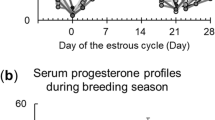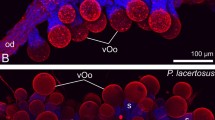Abstract
THERE are several types of glandular tissue in the mammalian ovaries and in the adjacent mesovaria, which are generally described as interstitial gland cells1. The different views regarding their origin have been reduced by Brambell1 to two comprehensive theses, namely epithelial origin and the connective tissue origin of the interstitial cells. No work has been done to compare or to contrast the cytochemical nature of these different types of cells in the ovary of the same mammal. Most of the cytochemical work has been carried out on the interstitial cells of thecal or connective tissue origin in the ovaries of a variety of mammalian species2–7. The ovaries of non-pregnant and pregnant grey bats (Myotis grisescens) show two types of interstitial cells3,8. The first type of cells are considerably developed and occupy all the ovary except the periphery which contains small follicles; they originated by the thecal hypertrophy of atretic large preantral and antral follicles and they are apparently developed to the same extent in the ovaries of pregnant and non-pregnant bats3. Mossman et al.9 have recently designated these cells of thecal origin as the interstitial gland cells in the mammalian ovary. The second type of interstitial cells in the bat ovary are in the form of cords of small epithelial cells, which are irregularly distributed among the first type of interstitial cells. The present investigation was undertaken to determine the nature of both types of interstitial cells by comparing and contrasting their cytochemical changes in the ovaries of non-pregnant and pregnant bats (Myotis grisescens) which were collected from January to June in the U.S.A. The fixing fluids and cytochemical techniques previously reported were also used in this investigation.
This is a preview of subscription content, access via your institution
Access options
Subscribe to this journal
Receive 51 print issues and online access
$199.00 per year
only $3.90 per issue
Buy this article
- Purchase on Springer Link
- Instant access to full article PDF
Prices may be subject to local taxes which are calculated during checkout
Similar content being viewed by others
References
Brambell, F. W. R., in Marshall's Physiology of Reproduction, third ed. (edit. by Parkes, A. S.), 1 (Longmans, Green, London, 1956).
Jacoby, H., in The Ovary (edit. by Zuckerman, S.), 1 (Academic Press, New York, 1962).
Guraya, S. S., and Greenwald, G. S., Anat. Rec., 149, 411 (1964).
Guraya, S. S., and Greenwald, G. S., Amer. J. Anat., 114, 495 (1964).
Guraya, S. S., and Greenwald, G. S., Amer. J. Anat., 116, 257 (1965).
Guraya, S. S., Amer. J. Obst. Gynec., 96, 907 (1966).
Guraya, S. S., Amer. J. Obst. Gynec. (in the press, 1967).
Guthrie, M. J., and Jeffers, K. B., J. Morph., 62, 523 (1938).
Mossman, H. W., Koering, M. J., and Ferry, D., Amer. J. Anat., 115, 235 (1964).
Author information
Authors and Affiliations
Rights and permissions
About this article
Cite this article
GURAYA, S. Cytochemical Study of Interstitial Cells in the Bat Ovary. Nature 214, 614–616 (1967). https://doi.org/10.1038/214614a0
Issue Date:
DOI: https://doi.org/10.1038/214614a0
This article is cited by
-
Das elektronenmikroskopische Bild des Ovars juveniler Ratten und Kaninchen nach Stimulierung mit PMS und HCG
Zeitschrift f�r Zellforschung und Mikroskopische Anatomie (1969)
-
The localization and functional significance of alkaline phosphatase in the vertebrate ovary
Experientia (1968)
-
Cytochemical observations concerning the formation, release, and transport of lipid secretory products in the interstitial (thecal) cells of the rabbit ovary
Zeitschrift f�r Zellforschung und Mikroskopische Anatomie (1967)
Comments
By submitting a comment you agree to abide by our Terms and Community Guidelines. If you find something abusive or that does not comply with our terms or guidelines please flag it as inappropriate.



